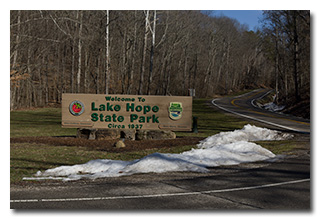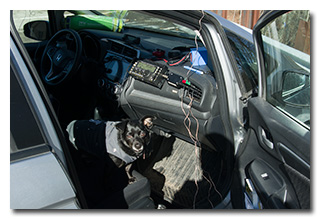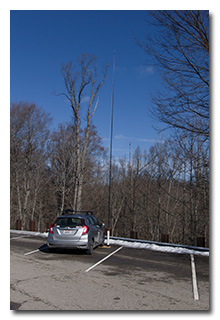
by William Eric McFadden
From the Lake Hope State Park website:
-
Though the roar of the iron furnaces no longer echoes through the hills of Vinton County, there are many reminders of days gone by at Lake Hope State Park. Situated at the northern edge of Ohio's Hanging Rock iron region, the park reflects the rich history of southeastern Ohio's industrial past. Built in 1853-54, the Hope Furnace processed the iron ore extracted from the region’s sandstone bedrock. The iron resulting from the ore smelting process was used to produce many different items including ammunition and cannons for the Union Army during the Civil War. Hundreds of men labored, cutting timber, working the furnace, and driving teams of oxen hauling iron ore to the furnace. Charcoal fires, needed to fuel the furnace, were tended 24 hours a day. So much wood was required for this process that the surrounding hillsides were almost completely stripped of their timber.
At the height of the Hope Furnace’s production, Ohio was one of the nation’s leading producers of iron. As time passed, iron ore was discovered farther west, and Ohio’s reputation as a major iron producer waned. The Hope Furnace shut down in 1874, after only 20 years of operation. By 1900, nearly all the major furnaces in southern Ohio were shut down. Today, the Hope Furnace chimney and some of the foundation are all that remain of the structure. Near the chimney, one may find pieces of slag, the cast-off residue from the smelting process. These pock-marked, glass-like pieces have now become a part of the forest floor.
The forest we now see is one that has grown back in place of the primeval forest that once stood hundreds of years ago. For a time, coal was an important Vinton County export. Many mines tunneled into the hills and large quantities of coal were transported out utilizing ox-drawn coal cars, and later the railroad. Most of the mines were abandoned early in the 20th century. Lake Hope Forest Park was created in 1937 by the Division of Forestry. The lands became Lake Hope State Park in 1949 when the Ohio Department of Natural Resources was created.
From the Zaleski State Forest website:
-
The 27,822-acre Zaleski State Forest is the second largest forest in Ohio's system of state forests.
Zaleski State Forest operates the only state-owned sawmill in Ohio. The mill produces rough sawn lumber for use by Ohio’s state forests and state parks as well as other government agencies.
Historic Moonville Tunnel is located within Zaleski State Forest on the Moonville Rail Trail right-of-way.
Pictures
Description
On Saturday, February 1, 2025, one member of the Southeast Ohio Radio Adventure Team performed successful simultaneous activations of Lake Hope State Park (US-1968) and Zaleski State Forest (US-5455) in Ohio as part of the Parks on the Air (POTA; link) program while participating in the annual Arizona ScQRPions Freeze Your B___ Off (FYBO; link) field operating event.
Eric McFadden, WD8RIF, performed the two-fer activation of Lake Hope State Park and Zaleski State Forest at the state park's Laurel Lodge parking lot. He was accompanied by his small dog, Theo.
Eric and Theo arrived at the Laurel Lodge at about 1530 UTC. Finding an out-of-way parking space, he parked his car and then walked Theo for a few minutes. Returning to his car, he deployed his 28½' end-fed wire as a vertical, supporting it on a 31' Jackite telescoping fibrglass mast in a drive-on base, and he placed three 17' counterpoise wires directly on the ground.
Eric had planned to operate outside, in the elements, at least for the first part of his operation, in order to maximize his FYBO temperature bonus. The outside temperature was in the mid 30s, and this would have been an acceptable temperature to be in if it hadn't also been windy. While outside in the wind deploying his antenna, Eric decided he would forsake the higher temperature bonus and operate in the relative comfort of his car. Mounting his Elecraft KX3 on his car's passenger-side dashboard, and powering the transceiver with a Bioenno 4Ah LiFePO4 battery so he would be eligible for the FYBO "Alternative Power" bonus, Eric was on the air at 1541 UTC. In order to try to earn a x3 bonus for a temperature at the key in the 40s, Eric started his operation with the car's front windows open.
As he had expected, Eric had cell-signal at this location and he would be able to spot himself, if needed, on the POTA Spots website (link), and he would be able to use POTA Spots to identify possible Park-to-Park (P2P) QSOs.
When Eric had previously operated at Laurel Lodge, he had found the place was electrically noisy, presenting an S9 noise floor. This time, Eric found that the noise was still present, but it was intermittent, and it presented an S5 noise floor when it was at its worst. Eric had come prepared to tear down his station and relocated to another location within the park if the noise was too bad, but with intermittent S5 noise, Eric decided to remain at Laurel Lodge, at least initially, and see what he could do.
Eric began his operation on 20m with the plan to operate as an FYBO station and only spot himself on POTA Spots if he determined he would otherwise have trouble validating his POTA activations. While hunting for FYBO participants, Eric found WA0KNP calling CQ for the Minnesota QSO Party and he completed a QSO at 1542 UTC. Tuning around failed to reveal even a single station calling CQ for FYBO, so Eric found himself a clear frequency and began calling "CQ FYBO". Eric's second QSO came at 1548 UTC with WA9LT in Illinois. This was followed at 1554 UTC by a QSO with KO4NTA in Florida. Neither of these stations sent the full FYBO exchange, so it seems they weren't participating in FYBO.
Five minutes after his QSO with KO4NTA, with no one responding to his calls of "CQ FYBO", Eric self-spotted himself on POTA spots and started calling "CQ POTA". His first QSO in this run came at 1603 UTC with N3VO in Maryland. QSOs came steadily, with Eric's fifteenth QSO in this run coming at 1620 UTC with a second QSO with KO4NTA, who either hadn't realized he had already worked Eric on 20m or had been concerned that Eric hadn't logged that first QSO. This run included QSOs with operators located in Alabama, Florida (4), Illinois (2), Maryland, Minnesota, Missouri, New Jersey, South Carolina, South Dakota, Texas, and Washington.
Eric finished his operation by hunting for P2P QSOs and, at 1624 UTC, he completed a P2P QSO on 20m with KA5TXN at Love Valley Wildlife Management Area (US-6358) in Oklahoma.
During his operation, the lowest temperature inside the car Eric recorded was 48°, making Eric eligible for the x3 temperature bonus.
In all, Eric completed nineteen QSOs, including one duplicate QSO and one P2P QSO, in about thirty-six minutes of on-air time. All of Eric's QSOs were CW and were made with a power output of five watts.
Eric was disappointed that none of the stations he had worked had sent the full FYBO exchange, and that he had failed to find any FYBO stations while he had been hunting for them.
For his FYBO operation, Eric submitted eighteen QSOs, twelve SPCs, and earned the x3 Temperature
Bonus, the x4 Field Bonus, and the x2 Alternative Power Bonus:
18 x 12 x 3 x 4 x 2 = 5,184 points
During station tear-down, Eric decided he would perform an impromptu activation of the nearby Turkey Ridge Wildlife Area, US-9509. Knowing that he would find no cell signal within that wildlife area, Eric attempted to announce his upcoming activation on POTA Spots so that he might be auto-spotted on POTA Spots when he started calling CQ at the wildlife area. However, the cell signal at the Laurel Lodge parking lot proved to be inadequate for him to successfully announce himself, and he ended up entering Laurel Lodge itself in order use the Wi-Fi within the lodge to successfully complete his announcement.
Eric also submitted his log to the World Wide Flora and Fauna in Amateur Radio (WWFF; link) program for an operation at Lake Hope State Park, KFF-1968.
(return)


